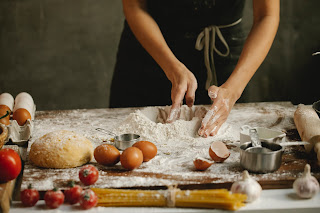No recipe? No problem!
No recipe? No problem! is the book I have been browsing through lately in my spare time. And, it is no coincidence that I have come across this book. I have actively looked to find something that speaks to my strange predicament: I host a monthly cooking program at the Hickory Corner Branch and I have been hesitating to give out recipes to participants.
No, not because the recipes are family heirlooms or super-secret or such. It’s because I trained to cook under my mother and my aunts and their idea of measurements ran in approximations. How much? was almost always answered by---a “fistful” of daal, a “thumb-size” ball of tamarind, a “pinch” of asafetida, a “spot” of coconut oil, and so on and so forth. Whose fist? Whose thumb? What a crazy question! Yours, of course!
Then, there were general principles of my native Konkani cuisine: which ingredients go together and, more importantly, which do not. There was an emphasis on eyeballing all of them, all together, and checking each based on relative quantities. There was also consideration of what the role of the end dish is in a balanced thali*. Oh, and as for the process, don’t forget to keep an ear out for the splutter of the rai in hot oil; a nose for how brown the lahsoon needs to be; look to see if the oil has separated from the sautéed masala; touch to check for tenderness of a cooked batata; finally, taste to check for balance. You see my predicament? How do you translate all of that? Would an attempt be too outlandish in the age of gadgets, cookbooks, recipes, and standardized measures?
The only way to know is to find out. So, each program, I begin at the beginning. The ‘no-cook’ aspect of the program allows me to pick recipes with fewer ingredients, serving as entry-points into a culture, a cuisine, or even a language. Also, I need not be the expert carrying the weight of knowing it all. I am one of the participants too, seeking to create something delicious with things at hand. And mind you, I am still winging it with dishes like Tzatziki and Htipiti, so that the whole journey is as exciting to me as to all participants.
Sometimes I hand out a recipe, other times I talk about the general principle for the recipe, and most times we talk about the memories certain food evokes. If a participant happens to ask how much? and I am about to say “fistful”, I bite my tongue and let another participant answer that on my behalf.
If I were to recreate my journey in learning to cook, I would say that these four books would be somewhat of a representation:
Give a man a recipe, he eats a meal. Teach a man to cook, he eats for a lifetime. How to Cook Without a Book follows through by focusing on a handful of techniques and a step-by-step narrative of how each technique works. A wonderful book for mastering a foundation.
A cooking circle of experienced cooks have put together recipes that focus on doing what you can with what you have in No Recipe? No Problem! An attitude of openness, flexibility, and curiosity are key to what they call “freestyle” cooking. A combination of stories, tips, and essential techniques, this book is a great resource to take your foundational ideas a step further in the direction of improvisational cooking.
Upon getting the hang of improv cooking, an abundance of grains and vegetables are perfect ingredients to play with for variations. In Cook Without a Book: Recipes and Techniques for Part-time and Full-time Vegetarians we get the master formula and variations side by side and see the workability of the entire process.
Working with minimal pantry staples, The New York Times Cooking: No Recipe Recipes offers no-recipe recipes for some standard and some not-so-standard dishes. From complex variations, we come back full-circle to simplicity of ingredients, simplicity of process, simplicity at its best.
*A Konkani thali: A meal offering balance of all flavors---sweet, sour, salty, bitter, astringent, and spicy---in a single plate
- by Shilpa Shanbhag, Reference Librarian, Hickory Corner Branch Library





Comments
Post a Comment